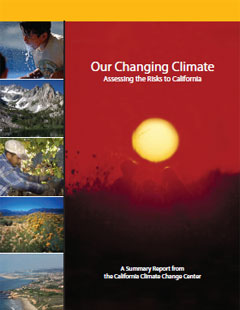In California and throughout western North America, signs of a changing climate are evident. During the last 50 years, winter and spring temperatures have been warmer, spring snow levels in lower- and mid-elevation mountains have dropped, snowpack has been melting one to four weeks earlier, and flowers are blooming one to two weeks earlier.
These regional changes are consistent with global trends. During the past 100 years, average temperatures have risen more than one degree Farenheit worldwide. California's climate is expected to become considerably warmer during this century—how much warmer depends on the rate at which human activities, such as the burning of fossil fuels, continue.
This new summary report highlights the latest scientific projections for how a global warming-induced warmer climate may impact California. These projections, based on state-of-the-art climate models, indicate that if global warming emissions proceed at a medium to high rate, temperatures are expected to rise 4.7 to 10.5 degrees F by the end of the century. In contrast, a lower emissions rate would keep the projected warming to 3 to 5.6 degrees F.
These temperature increases would have widespread consequences including substantial loss of snowpack, increased risk of large wildfires, and reductions in the quality and quantity of certain agricultural products. The growing severity of the consequences as temerpature rises underscores the importance of reducing emissions to minimize further warming.




